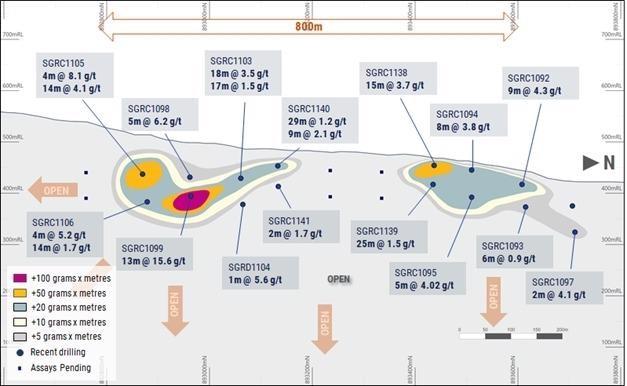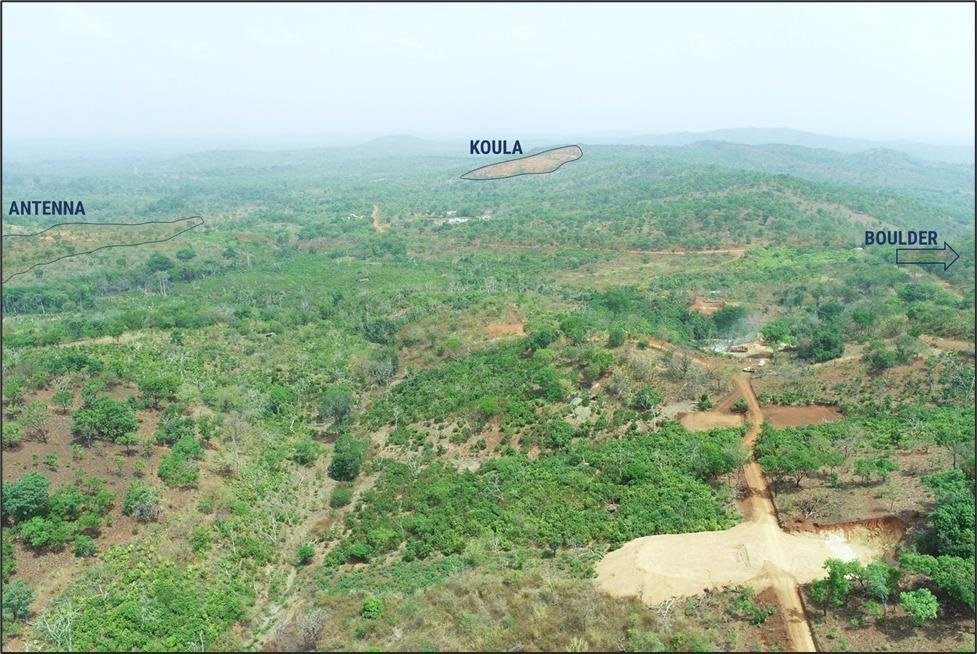Apr 7 2021
Roxgold Inc. (“Roxgold” or the “Company”) is pleased to announce initial results from the newly discovered Sunbird prospect, located less than 2 km from the primary Antenna deposit, at the Séguéla Gold Project (“Séguéla”) located in Côte d’Ivoire.
Additionally, the Company has continued to extend the Koula underground mineralized envelope drilling a further 120 m down-plunge from the previous deepest drilling at the high grade Koula deposit.
Séguéla Gold Project, Côte d’Ivoire:
Highlights from Reverse Circulation (“RC”) and Diamond tail (“RD”) drilling
Sunbird
- 13 metres (“m”) at 15.6 grams per tonne gold (“g/t Au”) in drill hole SGRC1099 from 111 m including 2 m at 86.6 g/t Au from 113 m
- 18 m at 3.5 g/t Au in drill hole SGRC1103 from 22 m, followed by a separate interval of:
- 17 m at 1.5 g/t Au from 54 m
- 4 m at 8.1 g/t Au in drill hole SGRC1105 from 58 m, followed by a separate interval of:
- 14 m at 4.1 g/t Au from 75 m
- 15 m at 3.7 g/t Au in drill hole SGRC1138 from 11 m
- 9 m at 4.3 g/t Au in drill hole SGRC1092 from 30 m
- 8 m at 3.8 g/t Au in drill hole SGRC1094 from 16 m, preceded by a separate interval of:
- 7 m at 1.5 g/t Au from 0 m
- 25 m at 1.5 g/t Au in drill hole SGRC1139 from 50 m including 1 m at 24.3 g/t Au from 57 m
- 29 m at 1.2 g/t Au in drill hole SGRC1140 from 21 m, followed by a separate interval of:
- 9 m at 2.1g/t Au from 68 m
- 5 m at 6.2 g/t Au in drill hole SGRC1098 from 34 m
- 4 m at 5.2 g/t Au in drill hole SGRC1106 from 123 m, followed by a separate interval of:
- 14 m at 1.7g/t Au also in drill hole SGRC1106 from 141 m
Koula
- 6 m at 10.8 g/t Au in drill hole SGRD1101 from 355 m including 2 m at 26.6 g/t from 358 m
“We continue to see the significant exploration prospectivity of Séguéla with the discovery of Sunbird, which has the potential to be another high grade prospect within close proximity to our planned operations and infrastructure,” stated John Dorward, President and Chief Executive Officer. “The initial results from Sunbird build upon the success of the discovery of Koula, as our exploration team has identified and targeted the north-south striking structure that hosts Koula and Ancien. Similar to Koula, our first round of drilling at Sunbird has returned consistent near-surface mineralization with high grade components over a larger strike length. Given the success of the first pass shallow scout drilling at Sunbird along an 800 m strike length, we are looking forward to the next phase of drilling testing the open nature down dip and along strike as we advance Sunbird through to resource status.
“In addition to the success at Sunbird, I am very pleased to see the continuation of the high grade Koula mineralization with SGRD1101 intersecting 6 m at 10.8 g/t Au, approximately 120 m further down-plunge from the previously deepest intersection of 14 m at 4.3 g/t in SGRD971. We now have high grade mineralization extending approximately 300 m down plunge from the base of the PEA pit shell and we are looking forward to results from further step-out drilling as we consider the potential for our first high grade underground resource at Séguéla. Importantly, the underground potential at Koula and Ancien, as well as the ongoing exploration success such as Sunbird, will continue to build the resource base at Séguéla beyond the Feasibility Study mine plan.
“While our exploration team continues their excellent work at Séguéla, the critical path for the Séguéla project plan is on track with the Feasibility Study nearing completion – which we believe will demonstrate the ongoing evolution of the Séguéla PEA with an enhanced mine life and project economics with the inclusion of the high-grade Koula deposit into the mine plan – followed soon thereafter by a construction decision towards the goal of achieving first gold pour at Séguéla in 2022.”

Figure 1. Séguéla deposits and satellite prospects. Image Credit: Business Wire
Sunbird
Located approximately 0.6 km to the south west of Boulder and 1.5 km south of Koula, Sunbird was discovered through following up regional soil geochemistry and surface mapping and is interpreted to be hosted by the same north-south striking mylonitic tholeiite/pillow basalt package that hosts Koula and Ancien. A possible link to the Boulder mineralization is also indicated in the regional aeromagnetic dataset highlighting a south-westerly extension and intersection of the Boulder structure with the tholeiitic unit. A 22 hole scout drilling program has delineated mineralization over at least 800 m of strike, with six holes pending results.
Mineralization is hosted by three sub-parallel quartz-carbonate vein sets associated with well developed mylonitic fabric within and along the interpreted margins of a tholeiitic basalt and consistent with the mineralization styles seen at Koula and Ancien. Mineralization remains open at depth and to the south where a moderate southerly plunge has been interpreted. Drilling to date has been limited to two holes per section line as part of a scout program. Further infill drilling is planned in Q2 after all results are received.

Figure 2. Sunbird assay results and assay status (contour of the westernmost vein set shown). Image Credit: Business Wire
Highlights from the first phase of the scout drilling program at Sunbird include:
- 13 m at 15.6 g/t Au in drill hole SGRC1099 from 111 m including 2 m at 86.6 g/t Au from 113 m
- 18 m at 3.5 g/t Au in drill hole SGRC1103 from 22 m, followed by a separate interval of:
- 17 m at 1.5 g/t Au from 54 m
- 4 m at 8.1 g/t Au in drill hole SGRC1105 from 58 m, followed by a separate interval of:
- 14 m at 4.1 g/t Au from 75 m
- 15 m at 3.7 g/t Au in drill hole SGRC1138 from 11 m
- 9 m at 4.3 g/t Au in drill hole SGRC1092 from 30 m
- 8 m at 3.8 g/t Au in drill hole SGRC1094 from 16 m, preceded by a separate interval of:
- 7 m at 1.5 g/t Au from 0 m
- 25 m at 1.5 g/t Au in drill hole SGRC1139 from 50 m including 1 m at 24.3 g/t Au from 57 m
- 29 m at 1.2 g/t Au in drill hole SGRC1140 from 21 m, followed by a separate interval of:
- 9 m at 2.1 g/t Au from 68 m
- 5 m at 6.2 g/t Au in drill hole SGRC1098 from 34 m
- 4 m at 5.2 g/t Au in drill hole SGRC1106 from 123 m, followed by a separate interval of:
- 14 m at 1.7g/t Au from 141 m
- 5 m at 4.0 g/t Au in drill hole SGRC1095 from 78 m including 1 m at 17.1 g/t Au from 79 m
The results of the 6 remaining scout holes are pending with geological logging highlighting consistent alteration and quartz veining along the projected mineralized zones.

Figure 3. Sunbird drill pads – looking north to Koula. Image Credit: Business Wire
Koula
Located approximately 1km to the east of Antenna, Koula was discovered through field reconnaissance and coincident recent artisanal workings in an area previously considered to be a lower exploration priority.
Results from the first of four drill holes testing the projected depth extensions approximately 120 m down-plunge from the previously deepest intersection of 14 m at 4.3 g/t in SGRD971 have been received, with SGRD1101 intersecting 6 m at 10.8 g/t Au from 355 m down hole. Geological logging of SGRD1102 and SGDD078 have highlighted the presence of the key structure and veining, with visible gold identified in quartz veining in SGDD078. Assays are pending and SGDD079 is in progress.
With high grade mineralization now extended approximately 300 m down plunge from the base of the PEA pit shell (refer Company press release March 9, 2021), infill drilling and further down-plunge extension drilling will be carried out in Q2 to determine the potential for an underground mining project at Koula.
Koula
- 6 m at 10.8 g/t Au in drill hole SGRD1101 from 355 m including
- 2 m at 26.6 g/t from 358 m

Figure 4. Koula assay results and assay status. Image Credit: Business Wire
Click here to view the full listing of drill results from the recent drilling programs at the Séguéla Gold Project. Note: all results are reported as down-hole intervals which represent approximately 65% of true width.
Catalysts and Next Steps
| Event |
Est. Timing |
| Ongoing infill, expansion and satellite target drilling program at Séguéla |
Q2 2021 |
| District exploration drill results at Yaramoko |
Q2 2021 |
| Underground drilling program in 55 Zone at Yaramoko Mine Complex |
Q2 2021 |
| Boussoura exploration results |
Q2 2021 |
| Feasibility Study for Séguéla |
Q2 2021 |
| Séguéla construction decision |
mid-2021 |
| Initial resource at Boussoura |
H2 2021 |
| Commissioning of Séguéla Gold Project |
H2 2022 |
Quality Assurance/Quality Control
All drilling data completed by Roxgold utilized the following procedures and methodologies. All drilling was carried out under the supervision of Roxgold personnel.
RC drilling used a 5.25 inch face sampling pneumatic hammer with samples collected into 60 litre plastic bags. Samples were kept dry by maintaining enough air pressure to exclude groundwater inflow. If water ingress exceeded the air pressure, RC drilling was stopped, and drilling converted to diamond core tails. Aircore (“AC”) drilling was collected in one metre intervals and sampled in a similar fashion to RC methods. Once collected, RC and AC samples were riffle split through a three-tier splitter to yield a 12.5% representative sample for submission to the analytical laboratory. The residual 87.5% sample were stored at the drill site until assay results were received and validated. Coarse reject samples for all mineralized samples corresponding to significant intervals are retained and stored on-site at the Company controlled core yard.
DD drill holes were drilled with HQ sized diamond drill bits. The core was logged, marked up for sampling using standard lengths of one metre. Samples were then cut into equal halves using a diamond saw. One half of the core was left in the original core box and stored in a secure location at the Company core yard at Séguéla. The other half was sampled, catalogued and placed into sealed bags and securely stored at the site until shipment.
All Séguéla RC, AC and DD core samples were shipped to ALS Laboratories preparation laboratory in Yamoussoukro for preparation. Samples were dried and crushed by the Lab and a 250-gram split prepared from the coarse crushed material, prior to pulverization and preparation of a 200 g sample. Samples are then shipped via commercial courier to ALS’s analytical facility in Ouagadougou, Burkina Faso where routine gold analysis using a 50-gram charge and fire assay with an atomic absorption finish was completed. Quality control procedures included the systematic insertion of blanks, duplicates and sample standards into the sample stream. In addition, the Lab inserted its own quality control samples.